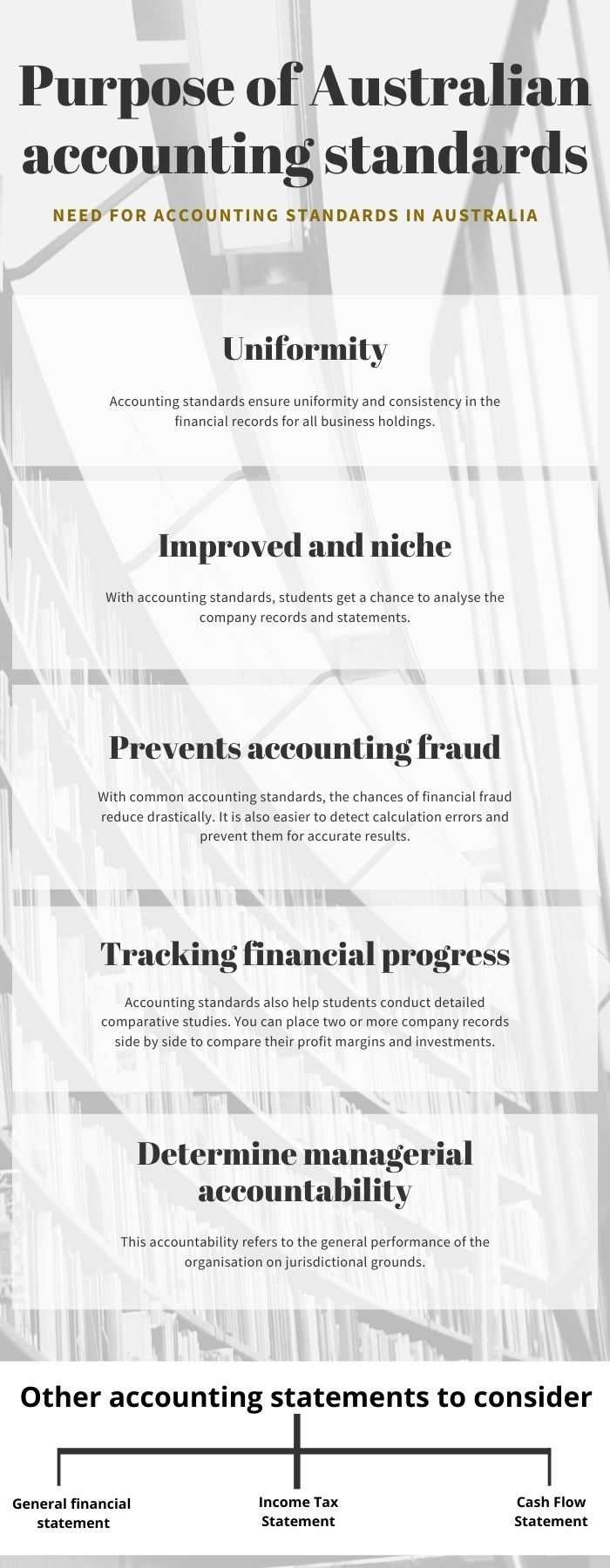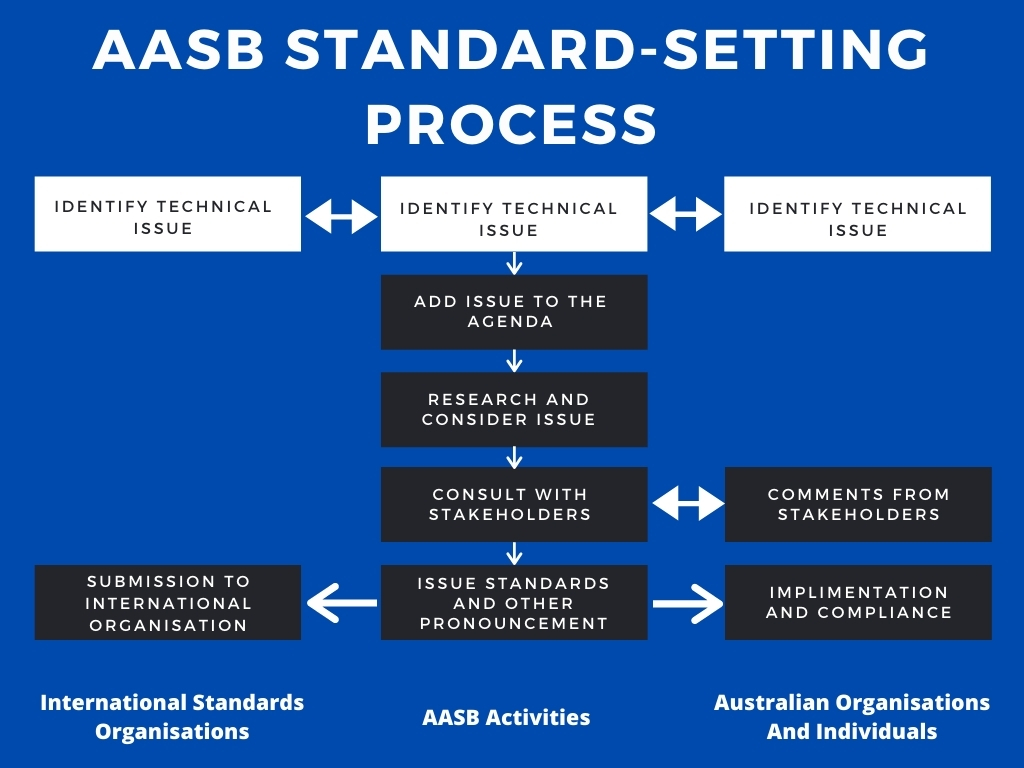What is the purpose of Australian Accounting Standards?

Accounting standards (AS) are policy documents that outline how we structure financial statements. It ensures transparent, credible, and consistent standards, maintained by all business holdings.
The accounting standard in Australia follow regulations by Australian Accounting Standards Boards (AASB). This government body maintains the financial statements and reporting standards for private and public enterprises.
Most B-schools include AASB principles, teaching students all about the theoretical accounting principles and its practical application. If you want some help to understand these accounting standards, then I got you covered.
Read on to know all about why you need accounting standards and how you can use it in your paper for a good score.
An average accounting cycle begins with journal entries and ends at the balance sheet.
The basics of Australian accounting standards
Before we begin to cover the basics of accounting standards in Australia, let us understand a few fundamental points. Now, AASB is a government body that follows the rules and practices set by the Australian Securities and Investments Commissions Act, 2001.
The accounting requirements also highlight the format of the financial statements raised by companies. Students learn about the accounting principles in the early semesters. In the final years, you get the practical experience of how to implement these concepts to actual company accounts.
Accounting standards include four main elements.
- Recognising the financial events
- Measuring the said economic events
- Present the financial records in a fair manner
- Disclosure of company requirements
The first point deals with keeping a steady record of financial events. There are various accounts and books to track everyday transactions in a company. Commercial development is when there is a monetary exchange between two or more parties. Investment, sales, inventory records, receiving payments- they’re all part of a company’s everyday transactions.
The second point deals with the calculative aspect of the financial records. The date, time and money recorded in each transaction is of vital importance here. And ultimately, this data is shifted to the ledgers, multiple accounts, and the ultimate balance sheet.
As per the Australian standards, there are two tiers of reporting financial events in company books.
Tier 1: Australian Accounting Standards
Tier 2: Australian Accounting Standards- Reduced Disclosure Requirements.
These practices also conform to International Financial Reporting Standards (IFRSs).
The third point is where you distribute the financial entries to the company’s final accounts. The accounting standards lay down the rules used to distribute the listings logically. The last point is where you disclose the company requirements. This is necessary to maintain transparency between the investors, auditors and other parties involved in the process.

Objectives of accounting standards
Accounting is generally accepted by the language of business enterprises. And like every language, even accounting has a few rules and syntaxes to follow. With the financial principals, students understand how and when to apply these concepts in realistic scenarios
Accounting standards also guide students, highlighting the dynamics that crop up when you transfer data between parties. Everyone who aims to record financial records of public/private sectors in Australia must follow these rules.
This information is valuable for investors, collaborators and business partners who’ve invested in the organisation. The financial statements also give deeper insights to the entrepreneur about how to allocate resources and distribute the funds prudently.
The Australian accounting standards comply with the global financial recording rules set by IFRS. This sets the AASB at par with the international yardstick. It is useful for auditors to identify the financial position of the enterprise
Need for accounting standards in Australia
In the earlier sections, I talked at length about the intent and purpose of having accounting standards to regulate finance in Australia. These principles bridge the gap between the concepts on paper and their practical implementation.
You must be wondering about the need for specific Australian accounting rules. What is the purpose of Australian accounting standards when we have a globally recognised system of financial recording?
Well, here, I will discuss the benefits of these standards set by AASB and how it adds value to company accounts.
Uniformity
Accounting standards ensure uniformity and consistency in the financial records for all business holdings. There are different rules for measuring financial institutions- from both public and private holdings.
Accounting standards also follow a common format, making things easier for auditors. Irrespective of the size, scalability of the venture, everyone gets a fair chance to track their progress. This consistency also makes financial records valid and authentic.
Improved and niche
With accounting standards, students get a chance to analyse the company records and statements. The Australian accounting regulations, in particular, is specific to the economic environment of the country.
The accounting principles cater to the needs of profit and non-profit organisations. Once you understand these statements, you can review how businesses work and transact holistically. The AASB, therefore, is more niche when compared to the global accounting standards.
Cashflow statement gives the students an idea about the financial stability of the company.
Reliable and credible
Accounting standards, though limited in scope, is far more reliable. This is because these standards are approved by the government. These regulations also include regulations by IRFS. The stakeholders, creditors and investors find this data trustworthy.
The present and potential investors find this information crucial to the decision-making process. It presents a comprehensive picture of the company. The basic design and features included in AASB outline the powers and functions of auditors.
Prevents accounting fraud
With common accounting standards, the chances of financial fraud reduce drastically. It is also easier to detect calculation errors and prevent them for accurate results. Students can cite these accounting standards to explain why and how a company tweaks its financial records.
Ensure that you cite these accounting theories and back it up with case studies and research papers. I recommend students to opt for APA or Harvard referencing as they’re ideal for stat-based documents.
Tracking financial progress
Accounting standards also help students conduct detailed comparative studies. You can place two or more company records side by side to compare their profit margins and investments. This also influences market research and analysis to a large extent.
The financial statements, developed on the AASB, give you a fair idea about how a company is faring in the current business environment. Students can refer to the accounting standards for some extra brownie points
Determine managerial accountability
This accountability refers to the general performance of the organisation on jurisdictional grounds. The year-end company accounts also shed light on the internal affairs of the organisation. It highlights how well-managed or mismanaged the enterprise is at the end of the day.
Accounting standards maintain consistency within the company. It sets the yardstick to measure the brand’s performance and reach. It also simplifies error detection and rectification for improved accuracy.
Other accounting statements to consider
The accounting standards help develop several financial statements for calculating the earnings of a specific fiscal year. An average accounting cycle begins with journal entries and ends at the balance sheet. In-between, you find these particular accounts, designed as per the AASB accounting standards.
General financial statements
The general-purpose financial statements (GPFS) are for companies that don’t have enough funds to separately present their financial records. This is why some organisations choose to release GPFSs along with public documents.
These financial statements are published along with public financial journals tailored to suit their needs.

Income tax statement
Taxes are an indispensable part of any accounting statement. And the income tax is usually chargeable on the assets and profits generated at the end of the year. Students must understand the tax filing procedure for better clarity of accounting standards.
Up until 2005, Australia used the deferred tax accounting method. This was the difference between the permanent and timing accounting profits and taxable income. With income tax, students also learn about how the govt. Earns revenue off business holdings.
Cashflow statement
Cashflow statements determine the cash-in-hand left towards the end of the year. With this statement, students can understand how and why the cash is leftover in the company. Cashflow adds flexibility within the organisation.
The cashflow statement also gives the students an idea about the financial stability of the company. It gives you a chance to analyse the everyday transactions and management for simple, small-scale operations.
Quick Links And References
Here are some reference books and documents you can read for more information on the accounting standards. These sources are taken from govt websites, so you can cite them for your next paper. Check it out below
The standard-setting process for AASB
IFRS application and significance
Accounting Structure, Specification, and Inference in Empirical Accounting Research
Citation generator- citethisforme
The Bottom Line
Accounting and finance are integral to how we conduct business in Australia. B-schools follow the latest accounting standards, relevant to the modern-day economic situation of the country. You can consult your peers and professors about the recent improvisations in accounting standards
Until then, I hope that this blog helps you get a basic idea about accounting standards. Consider this blog as an introduction to financial statements for a beginner. Good luck with your next assignment.


